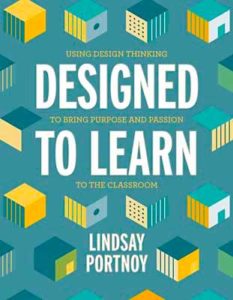Purpose and Passion through Design Thinking
Designed to Learn: Using Design Thinking to Bring Purpose and Passion to the Classroom
By Lindsay Portnoy
(ASCD, 2020 – Learn more)

In its sophisticated checklists, grounded research, and illustrative classroom stories, Lindsay Portnoy’s Designed to Learn: Using Design Thinking to Bring Purpose and Passion to the Classroom will inspire you to fine-tune or jump-start your design thinking approach.
While reading, I found myself appreciating the book’s rich structure, which features in each chapter a salient quotation, questions for teachers and students, matrices to determine priorities, and “notes from the field,” among many other elements.

After an introduction in which she argues for student agency – “Nowhere is student voice more influential than in a classroom of experiential learners using the lens of design thinking to solve problems in their world and work together to create a more sustainable future” – Portnoy arranges the chapters by giving background on and then itemizing the steps of design thinking:
- Finding Purpose in Learning
- Teacher and Student Roles in the Design Thinking Classroom
- How Not to Recreate the Wheel: Same Objectives, Different Pathways
- Understand and Empathize: Stepping Back Before Stepping In
- Identify and Research: Symptom or Root Cause?
- Communicate to Ideate: Pulling Together to Design Innovative Solutions
- Protoype and Test: The Messy Path Forward
- Iterate and Reflect: Reinforcing the Power of Formative Feedback
- Applying Knowledge to Practice: Isn’t That the Point?
Design Thinking = World Changing
The quotations that open each chapter highlight innovators as disparate as Zora Neale Hurston and Albert Einstein. I especially appreciated the epigraph in Chapter 1: Finding Purpose in Learning from J.K. Rowling: “We do not need magic to change the world, we carry all the power we need inside ourselves already. We have the power to imagine better.”
This strand of reform and social justice runs throughout the book. Further on in the first chapter, Portnoy suggests that design thinking can help create global citizens: “As students begin to see how their designed solutions may affect the world around them, they learn through active inquiry alongside peers, educators, and members of their local and global community. This is the 21st century’s version of a cognitive apprenticeship,” learning knee to knee with colleagues young and old.
The book as a whole encourages students to get involved in solving worldwide issues. In Chapter 9: Applying Knowledge to Practice, Portnoy connects the personal to the public by asking teachers to acknowledge their students’ passions as well as their own, “to reveal the beautiful diversity each of us brings to the classroom and the many ways we can apply our knowledge to solve pressing problems.”
Flexibility in Teaching
To achieve such purpose and impact, the book encourages us to depart from dyed-in-the-wool plans and assumptions whenever possible.
I like to think I’m a teacher who embraces project-based, student-driven learning, but I still found myself newly engaged while reading Designed to Learn, jotting down tons of notes on how to improve a major Constitution unit that has always felt lackluster.
Portnoy winks at us early on by saying: “So here’s your permission slip. You are hereby permitted to depart from the regularly scheduled program, try something new, and invite your students to play a role in active learning. By doing so, you’ll provide meaningful experiences that deepen knowledge acquisition and cultivate curiosity among our youngest citizens.”
An excellent place to “depart” starts with three Cs, she says. We can ask ourselves when students were “curious, confused or connected” about a unit we’ve done. This trio of terms energized me in its combination of emotional and intellectual considerations.
She also reminds us that teaching looks different under a design thinking model – that “a unit that typically includes six days of direct instruction may have just one day of direct instruction…, with five days of scaffolded research, ideation, testing, and reflection.” There’s more cacophony and, often, more engagement.
Wise Graphics to Help with Planning and Organization
One of the book’s most useful takeaways are the charts and checklists that dot its pages.
In Chapter 2, Teacher and Student Roles in the Design Thinking Classroom, a “Framework for Student and Teacher Expectations” covers questions from How will you seek feedback? to What do you do when you’re stuck?
The same chapter also gives a “HEARTS Before Heads” list of questions for students, focusing on Home, Educational experiences, Activities, Reasons for learning, Transformative life experiences, and Special attributes. An example under Reasons for learning is “If you had an entire day to do anything or go anywhere, where would you go and what would you do, and why?” With answers to these deeply thoughtful prompts, teachers can connect student dreams with classroom goals.
Other excellent charts include “Action Priority Matrix” in Chapter 6, which categorizes solutions on axes of effort and impact, and “Application-Process-Future Model” in Chapter 8, which spurs students to reflect on solutions and feedback to determine next steps.
Each chapter also contains “overarching” student and teacher questions, such as this one from Chapter 7: Prototype and Test: “What additional concepts not previously aligned to the curriculum are addressed by the prototype and provide practice using skills essential to 21st century learners?”
How to Begin Using This Book
To get started with Portnoy’s book, teachers who have background in design thinking and project-based learning could look at the introduction and then dip into a chapter where they’ve wanted to sharpen their skills. For teachers less familiar with these frameworks, the first several chapters could give plenty of motivation for developing a new unit, while the later chapters ask questions to help hone the unit’s structure.
By the time I finished Designed to Learn, I felt refreshed and finally ready to overhaul the Constitution unit that has needed more student voice for a while now. Armed with this book, as well as Fault Lines in the Constitution and a MiddleWeb article about history design that I’ve always wanted to act on, I can’t wait to dig in!
You can read Lindsay Portnoy’s recent MiddleWeb article here.
Sarah Cooper teaches eighth-grade U.S. history and is dean of studies at Flintridge Preparatory School in La Canada, California, where she has also taught English Language Arts. She is the author of Making History Mine (Stenhouse, 2009) and Creating Citizens: Teaching Civics and Current Events in the History Classroom (Routledge/MiddleWeb, 2017). She presents at conferences and writes for a variety of educational sites. You can find all of Sarah’s writing at sarahjcooper.com.

































